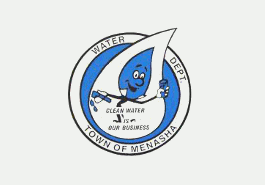Stormwater Management Information
Stormwater Management Plan
Why decrease polluted stormwater runoff?
Polluted stormwater has many adverse effects on ground water, surface water bodies, and wildlife habitats.
When it rains, water runs off streets, parking lots, construction sites, and lawns and into ditches, gutters, and storm sewers. This water picks up and carries pollutants and sediment as it travels and eventually ends up in our lakes and rivers without wastewater treatment.
This sediment often carries phosphorus to water bodies because phosphorus compounds attach easily to soil particles. Phosphorous pollution is a concern because in promotes weed and algae growth in lakes and streams, which can be harmful to the health of humans and wildlife.
Where do storm drains go?
A storm sewer system drains excess rain water from paved surfaces (streets, parking lots, sidewalks, and roofs).
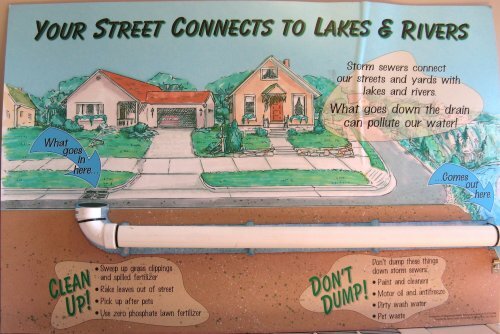 Photo: University of Nebraska, Lincoln
Photo: University of Nebraska, Lincoln
This runoff can include leaves, lawn clippings, animal waste, fertilizer, soil and dangerous pollutants such as oil, antifreeze, and paint. Anything that runs off driveways, streets, lawns, sidewalks and roofs is carried through the storm sewer system and directly deposited into water bodies. These pollutants can cause events such as fish kills and algae blooms that are not only unsightly, but harm the entire underwater ecosystem.
What are Illicit Discharges?
An Illicit Discharge is the discharge of pollutants or non-storm water materials to storm sewer systems via overland flow or direct dumping of materials into a catch basin.
Illicit discharges enter the system through either direct or indirect connections.
- · Direct connection: wastewater piping either mistakenly or deliberately connected to the storm drains instead of sewer system
- · Indirect connection: infiltration into the municipal stormwater sewer system from cracked sanitary systems, spills collected by drain outlets, or paint or used oil dumped directly into a drain
Illicit discharges contribute to high levels of pollutants including heavy metals, toxics, oil and grease, solvents, nutrients, viruses, and bacteria entering receiving water bodies. Pollutant levels from these illicit discharges are high enough to significantly degrade receiving water quality and threaten aquatic, wildlife, and human health according to EPA studies.
If you witness anyone dumping substances into storm drains or any mysterious substances in or around storm drains or in local water bodies, please contact the Town of Menasha Department of Community Development at 920-720-7105.
Best Management Practices for Reducing Stormwater Pollution
Impervious surface reduction
Reduce of impervious surfaces to increase infiltration & decrease runoff. As impervious (paved) surface increases, soil infiltration decreases and stormwater runoff increases.
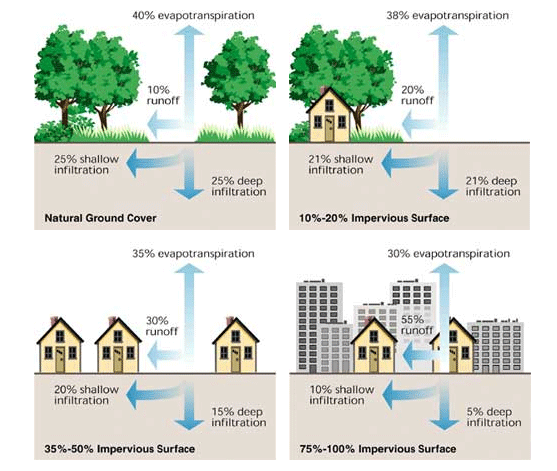 Figure: Federal Interagency Stream Restoration Working Group
Figure: Federal Interagency Stream Restoration Working Group
Rain barrels
A rain barrel reduces runoff by collecting and storing rainwater from your roof. Most often, a rain barrel is a recycled 55 gallon drum. Other components may include: vinyl hose, spigot, PVC couplings, and wire screen.
Reducing runoff is not the only benefit from a rain barrel. Collecting water with a rain barrel provides a free source of “soft water” to homeowners. Rain water contains no chlorine, lime, or calcium that is common in municipal water supplies. Over a growing season, a rain barrel can help to significantly reduce your water bill!
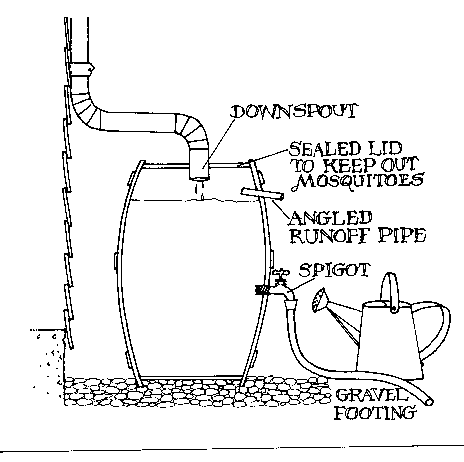 Image: Low Impact Development Center
Image: Low Impact Development Center
For more information on rain barrels:
- · Rain Barrel Guide
- · Center for Watershed Protection: How to Build and Install a Rain Barrel
Rain garden
Rain gardens can be used instead of or in conjunction with a rain barrel to further reduce runoff from your property. Rain gardens are sunken planting beds that can hold runoff from your roof, driveway, and lawn. They can also hold the overflow from a rain barrel during a heavy or long rain event.
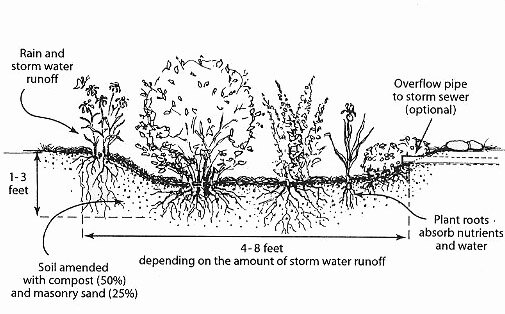 Figure: Cornell University
Figure: Cornell University
For more information on rain gardens:
- · UW Extension: Rain Gardens: A household way to improve water quality in your community
- · Wisconsin DNR: Wisconsin Native Plants for Rain Gardens
Lawn Care
Careless or over-fertilizing lawns and gardens leads to phosphorus rich soils in urban areas. During rain events, phosphorus is washed into storm drains and ends up directly in our lakes and streams.
Every fertilizer regimen should begin with a soil test. A soil test will tell you exactly what is lacking and help you tailor your fertilization and prevent over-fertilization.
Fertilizers come in a variety of combinations, and it is possible to get phosphorus-free fertilizers. Since most lawns are phosphorus rich, it is a great option to reduce phosphorus concentrations in our rivers and lakes.
Leaving grass clippings on the lawn prevents extra labor to dispose of clipping and adds extra nitrogen to the soil. After fertilizing or mowing, sweep hard surfaces toward your lawn or garden instead of the storm drain. This will prevent unnecessary nutrients from getting into the municipal stormwater sewer system.
If a fertilizer regimen is necessary, start it in the fall. Fall fertilization promotes root growth and will result in not only a healthier lawn, but a more drought tolerant one as well. Starting a fertilization regimen in the spring will promote leaf growth, which leads to increased lawn-mowing and unnecessary stress on the root system.
For more information on lawn care:
- · UW Extension: Rethinking Yard Care
- · UW Extension: Lawn & Garden Fertilizers


